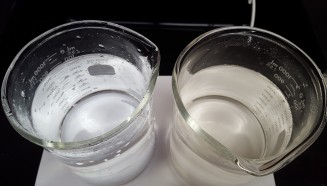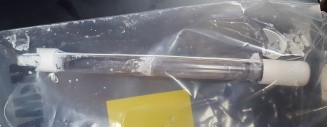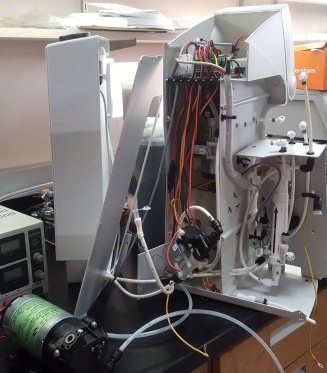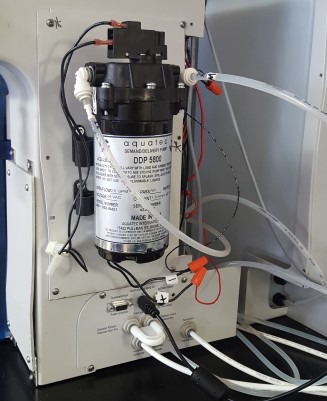 any people have wondered, at one time or another, why, after
spending billions of dollars and millions of person-years studying cancer,
heart disease, and Alzheimer's disease, we still have no cure. Often it's
not big scientific mysteries but mundane problems that get in the way.
any people have wondered, at one time or another, why, after
spending billions of dollars and millions of person-years studying cancer,
heart disease, and Alzheimer's disease, we still have no cure. Often it's
not big scientific mysteries but mundane problems that get in the way.
Last Tuesday our beloved two-year-old $4000 Barnstead Smart2Pure water purification system, which had been leaking for two months, finally stopped working altogether. Without purified water it's impossible to do experiments. Our tap water is brown. Even after passing it through a deionizer, there are so many metal ions in the water that chemicals just crystallize out of it instead of dissolving.

Purified water (left) and tap water (right)
Barnstead water purifiers
The most common problem in a Barnstead is a malfunctioning pump. We had four of an earlier model. They are nice little units and produce high quality water, but in each one of them the pump had to be replaced about once a year. When I opened the pumps up, about a hundred grams of rust would typically fall out because water had gotten inside and corroded the big permanent magnet.
This time there was no rust, but after the pump started leaking a bearing in the pump seized up. Water was also dripping out of the UV light fixture. The lamp connectors were all corroded and the glass tube inside the UV unit was full of white milky water. It was impossible to get the lamp out without breaking it.

UV sterilizing bulb extracted from Smart2Pure
These units aren't terribly complex, but they're now harder to repair because in their efforts to make the system more compact, the manufacturer turned it into a rat's nest of tubing, wires, and relays. The plastic cabinet was enclosed on three sides and jammed so tightly with components it was impossible to see where the tubing went. The tubing was so short I had to replace much of it just to get the unit apart. And those push-to-connect fittings are easy to install but hard to take apart without breaking them.
The vendor, Thermo, long ago outsourced their tech support to a company called Unity, which told me a replacement pump, part no. 50149264, would take at least two months and cost $324. They come with 5/16" push-to-connect fittings and 5/16 to 1/4" elbow adapters to connect the pump to the 1/4" tubing used elsewhere in the unit. But they're not hard to fix once you get used to the design and do a little surgery on the cabinet.
Supplies needed
- A push-to-connect removal tool (e.g., Sharkbite) or a home-made tool.
- Racheting screwdriver with extendable bit holder (e.g., Dewalt DWHT66547) and bit set.
- Extra tubing (semi-clear is preferred so you can see whether water is moving) (1/4" OD, nylon, McMaster 5548k75).
- Several boxes of paper towels.
- Dremel with cutting wheel.
- 25-volt DC power supply (Extech 382200 highly recommended). Don't use an electrophoresis power supply.
- Wire cutters and wire nuts.
- Tubing cutter for plastic. Commercial ones aren't sharp enough to actually cut anything, but they compress the end of the tubing so it doesn't destroy the push-to-connect fitting. A razor blade cutter with a guide would be better: the end has to be straight and smooth or it will leak.
- A large supply of extra push-to-connect fittings. They tend to leak after a couple of uses.
- Large bottle of Excedrin Extra Strength.
Procedure

Barnstead water purifier with almost every component removed to access the lower pump

Water purifier after surgery. These pumps are consumable items, so we mounted it outside the cabinet on an extra piece of steel that was left over after we reassembled it. The rectifier at the top is supposed to turn this into an AC pump, but is not needed and has been disconnected
- To remove the pump you need to take the system completely apart. Make a detailed diagram of each screw and each connection. Label each screwhole, both ends of each piece of tubing, and each component using labeling tape if necessary. I had a whole page on how to get the back cover off.
- Once you get it open, the hard part is done. Make a diagram of the electrical connections. This will enable you to use a DC power supply to test which motor has failed.
- Cut large openings in the front and side panels so the pump can be pulled out from the front. Most of the components in the outer compartment have to be removed before you can unscrew the pump.
- Replace the tubing leading to the tank with 3-foot lengths of new tubing and keep the tank as a separate box. This step and the previous one aren't technically necessary but they will make repairs much less stressful next time around. And there will be a next time.
- The Smart2Pure has two Aquatec 5800 series 24VDC 0.36 GPM pumps. Barnstead calls the upper pump a booster and the lower pump a circulating pump. See here for a diagram of the plumbing and electrical connections. We un-seized the frozen bearing by putting a few drops of acetone on it. There was also a tear in the triangular diaphragm, which turned out to be made of Santoprene, a type of thermoplastic, not silicone as we feared, and we repaired it easily using a plastic welder.
- After reassembly, the pump leaked again after a few hours of operation, so we replaced the two O-rings, the larger one with a 3 mm width instead of 2.5 mm.
- Aquatec doesn't seem to want to sell to end-users. Their sales department never responded to our emails. This makes the Barnstead much harder to repair. We ordered a pump, a model 5844-8E01-B594, for sale at a company in Ontario. Unfortunately the company had trouble filling the order at the manufacturer and we had to cancel the order.
We ended up with a nice open-floor design for the cabinet, leaving the tank separate (through 3-foot lengths of tubing) instead of attached to the back of the unit, and we left the front, sides, and back open. This lets us see right away when (not if) it starts leaking again.
Although my admiration for this company's engineering skill has dimmed slightly, I still think it's a very good product. The conductivity comes up to 18.2 MΩ-cm in just a few minutes. However, as fashionable as these rounded, artistic, vinyl plastic cases may be, they're too flimsy. That's undoubtedly why Barnstead had to partition the inside into little cubbyholes and cram everything together. Equipment needs to have side, front, and back heavy aluminum panels that can be easily removed. For what companies charge for this stuff, that shouldn't be a problem. And for heaven's sake, make them square so we can put stuff on top of them.
Some of my colleagues look at fixing equipment as an arcane skill that they could never learn. But everything, even in biology and chemistry, is just a mechanism. The difference is that in biology and chemistry the parts are a lot smaller, and unlabeled. A water purifier is just a lot easier to cure.
We also ordered a 24-volt pump (5351-1L02-B421) from Fresh Water Systems, a nice company, not realizing it was AC instead of DC. Upon taking it apart, we realized it was just a permanent magnet DC pump with a rectifier stuck on top. The only difference was that the connectors were 3/8 inch instead of 5/16. The rectifier can't be removed without making it spring a leak, so the pump doesn't fit into the designated space, but bypassing the rectifier worked and we mounted it on the outside of the cabinet. Don't move the pump around while it's running.
These pumps work equally well in either direction. A DC motor will rotate in different directions if the polarity is reversed. Since both wires on a formerly-AC motor are black, you have to empirically determine which way it's pumping. The re-engineered water system not only dispenses water faster, it is also now much easier to repair.
Due to the difficulty in obtaining replacement pumps, it's essential to have several spares on hand. I highly recommend these little units to my colleagues, but I am not going to volunteer to re-engineer one for them. Machiavellian? Not at all.
mar 11 2022, 4:05 am. last updated apr 26 2022
